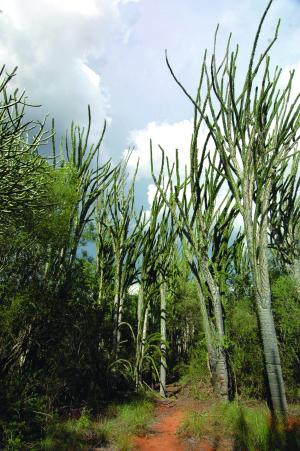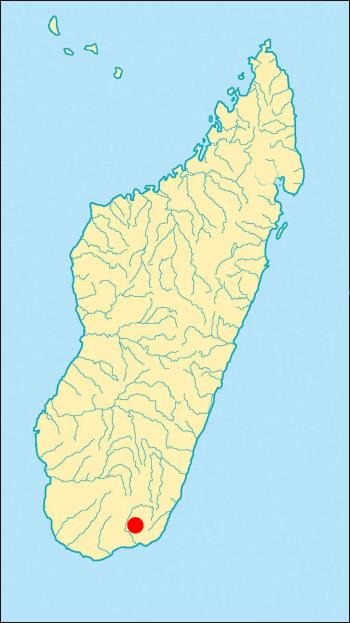You are here
Berenty Private Reserve ***

The Berenty Private Reserve is one of the best known tourist destinations in Madagascar. Established in 1936 as a reserve on a sisal plantation, it opened for tourism in 1980 and is still operated by the de Heaulme family, the original owners. Berenty is located approximately 82 km west of the airport at Tolagnaro (= Fort-Dauphin) and just north of Amboasary. The drive from Tolagnaro takes about three hours without stops (owing to the poor condition of the road). However, it is best to schedule a full day for this trip because the scenery and the attractions along the way make this one of the most interesting stretches of road in Madagascar. You start in the southern extreme of the eastern rain forest region in the land of the Antanosy people and drive through their small villages and markets, with a stop at a tomb site that has appeared in National Geographic (actually a monument, since the Antanosy bury their dead elsewhere). From there, you continue on through the transition zone between eastern rain forest and spiny forest, and have the option of diverting into the Tsimelahy region of Parcel III of Andohahela National Park. The small reception area for Tsimelahy is located some 8 km from the main highway on a very rough but passable dirt road. There is a well-laid out trail at Tsimilahy in a very picturesque spot that mixes elements of the spiny forest with several species endemic to the transition zone itself. The best known of these endemics is the famous triangle palm (Dypsis decaryi), a beautiful tree that is now grown horticulturally around the world, but is naturally found only in this tiny area. Tsimelahy is best described as a natural botanical garden, and definitely worth a visit. From there, you return to the main road and continue on into the land of Antandroy, the true spiny forest. Along the road are still to be found some expanses of intact spiny forest dominated by the magnificent Alluaudia plants of the Didiereaceae family, and you also pass several villages of the Tandroy people, who live in this very inhospitable environment. The Tandroy still cut spiny forest for charcoal, but a Japanese non-governmental organization (Southern Cross) has been working with local communities on alternatives, including replanting of Alluaudia, creating a small handicraft industry, and primary education. Visitors should stop at the village of Andranomainty, where one can buy simple but charming little wood carvings of lemurs, chameleons, and other animals, and at Antrehatreha, where residents sell model planes and helicopters made from local materials. Finally, at about 60 km from the Tolagnaro (= Fort-Dauphin) airport, you arrive at the region of the Amboasary-Sud sisal plantations, a vast expanse of these Mexican plants that were introduced in the first half of the 20th century. You pass through the village of Ambosary-Sud, turn north off the main road, and drive about 10 km through the plantations to Berenty. For those wishing to fly in by charter, there is also a small airstrip on the grounds of the plantation. If you can afford this option, we recommend flying first to Tolagnaro (= Fort-Dauphin) and doing the above route in one direction, then flying out from Berenty once your visit is over to avoid retracing your steps. Berenty has large populations of ring-tailed lemurs (Lemur catta) and Verrreaux’s sifaka (Propithecus verreauxi), which are very evident and usually in or near the parking lot, greeting visitors upon arrival. There is also an introduced population of hybrid red-fronted brown lemurs (Eulemur rufifrons) × red-collared brown lemurs (Eulemur collaris), the offspring of small groups of these two species that were introduced in the 1970s and 1980s. The introduced lemurs surely compete with the native species, probably to the detriment at least of the ring-tails, but they are there to stay. Three nocturnal species are also present. The white-footed sportive lemur (Lepilemur leucopus) is common and readily seen, even in the daytime in its sleeping sites. Research has also indicated that there are two mouse lemurs at Berenty, the gray (Microcebus murinus) in the gallery forests and the gray-brown (Microcebus griseorufus) in the adjacent spiny forest patches. Both are commonly seen in the warmer months. The Berenty Reserve is situated along the Mandrare River and covers approximately 250 ha of gallery forest dominated by large tamarind trees (Tamarindus indica) and adjoining spiny forest, dominated by Alluaudia procera and Alluaudia ascendens. These patches of natural habitat are in the middle of the sisal plantation that was established in 1930. Research on the ring-tails at Berenty has been going on for nearly 50 years, led by Dr. Alison Jolly and her colleagues and involving numerous other researchers. A number of publications by Dr. Jolly are readily available. The most recent of these is a fascinating book entitled Lords and Lemurs. It focuses both on the history of Berenty and on the behavior and ecology of the lemurs, and is highly recommended. Over the last 30 years, Berenty has probably been the most visited and most filmed of all sites in Madagascar. Bungalows are available for overnight stays, and there is also a good restaurant on the premises. Berenty is accessible all year round, but September and October are the favored months for observing baby lemurs, while December through March is the best time to see native reptiles. Temperatures in the austral summer can be quite hot and nights in the austral winter can be quite cool, so dress accordingly. You will also need to be sure to book well in advance since this is one of most heavily visited sites in the country, especially in the peak season. Although most visitors go only to the gallery forest and to a small, adjacent patch of spiny forest in the immediate vicinity of the bungalows, we also recommend excursions to several other forest patches in the area. These include the gallery forest of Bealokoa and the magnificent spiny forest patch at Anjapolo, located just 15 km from the headquarters of the reserve and still part of Berenty. The forest at Anjapolo is rich in Didierea trolli, an impressive species of Didiereaceae not found in the more frequented spiny forest patches in the main part of Berenty. Berenty is a must for first-time visitors, and often the first stop on any inaugural trip to Madagascar. Although sometimes crowded in the high season, it is still a delightful place and one where the lemur-watcher can immediately add four or five species to a lemur life-list. The reserve is also excellent for birdwatching, and has what must be the most accessible roosting site for the Madagascar flying fox (Pteropus rufus) in the entire country. It is also a good staging point for excursions to other parts of the southern extreme of the country, notably Cap Sainte Marie and Faux Cap which are well worth a visit.
